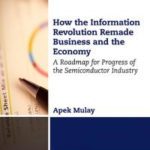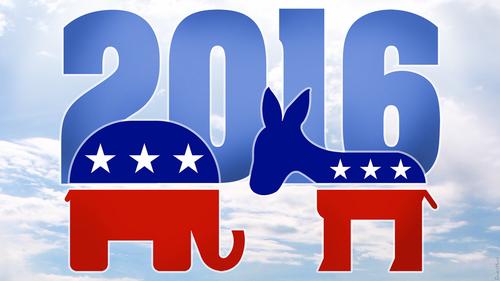The U.S. semiconductor industry business cycle, which typically lasts seven to eight years, has come to an end. For a variety of reasons, I believe that the U.S. stock market will decline rapidly in the near future, to the detriment of the semiconductor industry. Whoever is elected in November, will have a hard job ahead of them.
In my previous blog on EBN, I traced the seven-year business cycle in U.S. economy. Unfortunately, my forecasts made in 2015 did not come true. The economy has been stagnating since October 2015 and has also experience a major shock that summer with the crash of China’s stock markets. When Fed hiked its rates back in January 2016, there was a panic in international markets.
The federal government had initially proposed several hikes in its benchmark rate of interests in 2016. However, after the initial panic in early 2016, the Feds have backed off from its initial plan and I do not expect a rate hike anytime before the 2016 presidential elections. This move may not be political but it will surely create a panic in international markets. A decision to hike rates before the elections has the potential to favor Donald Trump’s candidacy for President as he has been warning that the U.S. economy is rigged. Whether the Fed decides to hike rates now or after elections, markets are going to crash.
There are few things that are happening in the present global economy that point to a crash after the rate hikes:
- The European Central Bank (ECB) and Japanese Central Bank (JCB) are increasingly going into the negative interest rate territory so that these countries will be able to export their goods to United States.
- China is increasingly getting rid of its holdings of U.S. treasuries as official ownership of U.S. government debt by China has declined in the past several months. Overall, foreign investors have sold $13.1 billion in U.S. government debt in July 2016, following $32.9 billion in sales in June 2016. This is going to worsen the crisis for U.S. economy.
- The monetary policy of the U.S. government and the fiscal policy adopted by successive U.S. governments since 1981 have resulted in wages trailing productivity of the U.S. workforce. This has created economic bubbles, which have eventually resulted in recessions at the end of every seven-year business cycle. Additionally, it has also resulted in spiraling of U.S. national debt to an unsustainable level.
- With the poor domestic purchasing power of U.S. citizens, U.S. multinational corporations (MNCs) have increasingly focused on Asian markets. However, with the crash of China’s stock market that country has changed its economic policy to focus on domestic growth rather than exports. As worker wages have risen in China, U.S. MNCs have started looking for alternative low cost manufacturing locations. However, MNCs have ignored how offshoring jobs add to US trade deficits. Similarly, politicians have underestimated the pervasiveness of corporate control over the U.S. economy.
All of the above point to the potential of U.S. voters turning to Donald Trump with their votes in an effort to oust elected representatives who they believe have deceived them for decades. They think it may be time to let an outsider come and fix the system to restore prosperity to the working class. I forecast that as soon as the Fed hikes its benchmark interest rates in December 2016, U.S. crony capitalism will meet a sudden collapse causing an economic chaos.
Now, let’s look at the policies a new president would have to adopt to help fix the U.S. economy.
For a healthy economy, in the past the desired equation was
Supply= Demand.
With wages trailing productivity since 1981, elected officials have been following what is known as monetary policy, which tempts people into larger debts. This eliminates unemployment as spending rises to the level of supply, because now,
Supply = Demand + New Consumer Debt.
The wage-productivity gap has been rising so fast that the government also had to raise its own spending and debt constantly, so that total spending matched rising supply. In this case:
Supply = Demand + New Consumer Debt + New Government Debt.
Hence, if the next president suggests that we cut business taxes and also cut size of government in order to spur economic growth, what will be the impact? Cutting the size of government will reduce government spending drastically. In the last equation above, the supply will be higher than demand and debt. That will result in excess supply and poor demand. In turn, that potentially may cause overproduction at manufacturing facilities and might result in layoffs. Just giving tax cuts and reducing size of government is NOT a solution to reducing the huge problem of unemployment in America. We have tried it and it didn’t benefit either the U.S. economy or the semiconductor industry.
As a result of huge tax cuts enacted during tenure of Ronald Reagan’s presidency in 1981, a major economic crisis hit in 1984–1985 and since then macroeconomic policies have resulted in boom-and-bust cycles that have plagued the US and global economy till date. Preparing for the rapid expansion of markets expected out of 1981 tax cuts, Intel Inc. licensed its 80286 microprocessor to other manufacturers, including AMD, Fujitsu, Siemens, and IBM. It was a big boom in 1983, into the middle of 1984—and then the semiconductor world suddenly collapsed in late 1984 and 1985. The resulting crisis caused Intel to lay off its workforce and shut down several factories due to lack of economic demand and resulting excess supply.
We must find a way to reduce the national debt but not at the expense of U.S. employment. The questions remain:
- How is the technology sector supposed to progress so that Industry 4.0 becomes sustainable?
- How can Moore’s law progress if there is huge unemployment and potential economic collapse?
- Is it possible to eventually envision an economy where More-than-Moore andBeyond CMOS Moore drivers proposed by International Technology Roadmap for Semiconductors (ITRS) get implemented for progress of global semiconductor industry?
- Can technological progress solve problem of huge unemployment created because of automation?
The answers to all these questions may be found early in 2017, after the U.S. economy hits its worst crisis. Given the vast unpopularity of our political institutions and resulting economy, the next U.S. president will face a lot of opposition not only from other political parties but also from politicians within his/her own political party. Any president who wants a second term and a chance to deliver on his/her promises made to electorate cannot continue the present status quo. The new president, with the right ideas, could bring about free market economic reforms without help of an un-cooperative congress.


Recent Comments